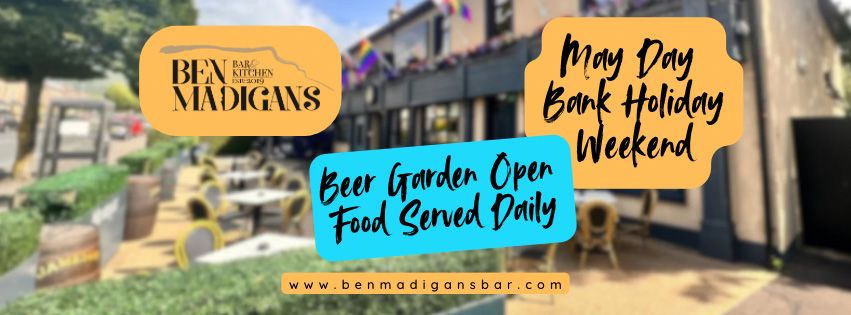BELFAST city centre, a heaving Friday lunchtime, and I’m about to find out first-hand what it’s like to be blind.
And what I find out is that while café culture has brought many positives to the city – who doesn’t enjoy a coffee or a glass of wine al fresco? – for the blind and partially-sighted and their guide dogs, casual street furniture on pedestrian walkways is making life much harder.
Accepting an invitation to spend the morning with the inspirational team from Guide Dogs NI (GDNI), whose mission is to work to ensure people who are blind or partially-sighted can enjoy the same freedom of movement as everyone else, I agreed along with Sinn Féin MLA Fra McCann to experience temporary sight loss with the aid of a blindfold and Emily, a black Labrador cross.
GDNI are currently spearheading the ‘Streets Ahead’ campaign, which aims to tackle some of the many barriers to accessible streets and pavements.
Andrew Murdock of GDNI told me about the difficulties facing the blind and partially-sighted as they navigate the busy streets of our city centre.
“The Streets Ahead campaign aims to tackle some of the frequent barriers to accessible streets,” he said. “Parking on pavements, for instance, which can force people to walk on the road and into the path of oncoming traffic. Street clutter, shop advertising boards or pavement café furniture can all become a barrier to a blind person trying to navigate their way through town.”
“Emily has been seven months in training,” explained instructor Colin Kerr. “It can take around 20 months of specialised training to transform a newborn puppy into a confident guide dog. We would usually spend four to six weeks training the dogs with their owners. Of course, every dog is different, just like people, so it’s important to match the right dog to the right person. We train Labradors, German Shepherds and occasionally we’ve even been known to have a Labradoodle,” he laughed. “Each dog has a different personality, they need handled differently. Emily prefers a nice, relaxed voice to respond to and is doing fantastically well in her training.”
I’m standing at traffic lights in Bedford Street with visually impaired David Cooper who told us he’s “in between dogs at the minute” due to his last guide dog retiring. Using his long cane to make his way around town he explained how small hidden plastic cones under the button tell him when it’s safe to cross the road. I never knew that, so I checked it out, taking a grip for myself, and when the green man appears, the cones start to spin, telling the person it’s safe to cross the road.
Making my way with David to Arthur Street I can’t believe how many things there are that I never give a second thought to, but which suddenly reveal themselves as obstacles when you’re with a person with a white stick: tables, chairs, blackboard menus, bins, advertising boards, BT cabinets. For David, it’s more like an assault course than a summer stroll through the city centre.
“During my time as a councillor a number of years ago I argued for a café culture in our city,” Fra McCann tells me. “But with that comes a responsibility to people who are blind or visually impaired in that they want to be part of that culture, not challenged by it. The kind of street furniture used to encourage al fresco dining needs to fit in, it needs to be thought about, it needs to be suitable so that it’s not an obstacle for those who are blind or disabled. It’s all about independence, confidence, and if that is knocked then a person just might not want to venture out.
“I’m a member of the all-party working group in the Assembly on visual impairment. Generally people are sympathetic, but there is no real understanding of the real difficulties that people face trying to get out, to get around.”
And then it’s my turn. With blindfold on, I’m plunged into temporary darkness and place my trust in Colin and Emily, but I’m apprehensive and uncertain. I follow Colin’s instructions and take my right foot back a step along with my right arm, bring them forward together, as if about to bowl on a green, and say simply to Emily “Forward”. And we’re off. I can see nothing, absolutely nothing, to the front, side or back and so Emily takes me on a journey through the city centre, weaving gently and regularly to guide me around pedestrians, chairs, tables, flower displays – you name it. Going back over the route later, I find that many of the obstacles would disappear – or at least become a little easier to navigate – if a little more thought went into their placement.
As we continue, I’m encouraged by Colin to acknowledge Emily’s excellent work with regular affectionate praise like ‘Good girl’ and ‘Well done.’ Gradually, my disorientation begins to wear off and I reach a fuller understanding of the vital job that guide dogs do – and how much easier that job could be with just a little help from the rest of us.
For more information visit www.guidedogs.org.uk
Pictures above from left, Emily finds a gap in the pavement for Fra McCann MLA, a member of the Assembly’s all-party working group on visual impairment; David Cooper is directed by a helpful member of the public; Colin Kerr and Emily show Ciara Quinn what a stroll in the city centre is like for the blind and partially-sighted






